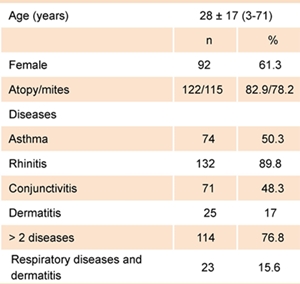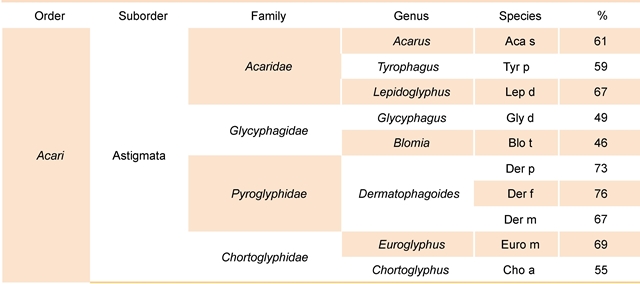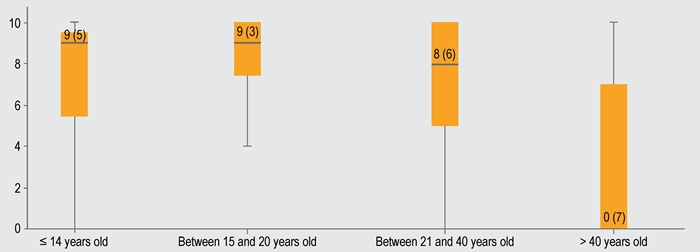Background
Allergies are a group of frequent diseases resulting from interactions between the genetic constitution of everyone and exposure to environmental factors. Although it can occur at any age, onset is usually in childhood and its prevalence appears to be increasing in developing countries, especially those located in the tropics.1,2
Atopy is an essential factor for the development of IgE mediated allergy diseases.3,4 Currently, the evaluation of atopy is done using extracts from suspicious sources in serological or skin tests measurements.5,6 Both procedures usually have good sensitivity and acceptable specificity. In most of the countries located in the tropics, mites are the main cause of atopy but, like pollen grains in Europe, mite species involved vary according to the environmental characteristics of each region, so the epidemiological studies have shown that not all populations are exposed to the same species.7,8 In the Latin American tropics much it is known about sensitization to Dermatophagoides pteronyssinus (Der p), Dermatophagoides farinae (Der f) and Blomia tropicalis (Blo t).9,10 However, despite that the conditions of this environment favors the growth of a wide variety of species, little has been studied the frequency of sensitization to other mites such as those belonging to the family Acaridae or Chortoglyphidae.
In a study in Egypt, Hossny E et al. evaluated the frequency of sensitization to 5 species of mites in a population of 100 patients diagnosed with asthma between 1 to 7 years, with Der p (11 %) the highest and Acarus siro (4 %) the lowest.11 This study found that patients with persistent asthma used to have a sensitization to at least 3 of the mites studied. Puerta et al.12 found that among 77 patients with asthma and/or rhinitis positive to Der f or Der p, over 70 % had sensitization to other mites (Der f 89 %, Ale o 68 % Blo t 80 %, Der p 75 % Cho 71 %, Lep d 59 %), indicating that sensitization in Cartagena is common to Pyroglyphidae mites (Der f, Der p) and mites from other families. Additionally, Puerta L. observed that different IgE binding patterns, suggesting that the sensitization to common allergens with cross-reactivity as allergens species specific occur.
Given the differences in the frequency of sensitization to mites in each environment, we assess the frequency of sensitization and their possible interactions of 10 different mites in a population of patients situated in a Latin American tropical city, enabling better understand of its impact on the diagnosis and treatment of allergies.
Methods
Geographicaland population
Medellín is a city of Colombia, located at coordinates 6°13′51″ N, 75°35′26″ W, between two mountains in the Aburrá Valley, at an altitude of 1479 meters above sea level, with a total area of 380.64 km2 of which 110 are urban ground and 270 rural. Since 2014 its temperature varies in a range between 15- 28 °C, with dry seasons during the early and midyear and a relative humidity of 63-73 %.
This is a cross-sectional study based on records of a cohort previously formed in Medellín, Colombia.13 Briefly, the cohort was formed from 300 patients and for this nested study those subjects who were tasted for the full panel of mites available at the institution and had manifestations of asthma, rhinitis, dermatitis and/or conjunctivitis were selected. Selection was not limited by age or gender. The diagnosis of the diseases studied was carried out following the criteria proposed by various international guidelines such as GINA Guidelines for Diagnosis of Asthma (ginasthma.org), the ARIA guide for diagnosis of rhinitis and/or conjunctivitis and SLAAI guideline for diagnosis dermatitis.14,15
Evaluation of atopy
The presence of atopy was assessed by skin prick tests using standardized commercial extracts of laboratory Leti (Madrid, Spain) to 10 mites: Blomia tropicalis (Blo t), Der p, Der f, Acarus siro (Aca s), Chortoglyphus arcuatus (Cho), Dermatophagoides microceras (Der m), Euroglyphus maynei (Eur m), Glycyphagus domesticus (Gly d), Lepidoglyphus destructor (Lep d) and Tyrophagus putrescentiae (Tyr p). International recommendations were taken into account for interpretation of skin prick test, considering as positive a wheal greater than 3 mm relative to the negative control.16 All patients before the test discontinued consumption antihistamines or other drugs that might interfere with the result.
Ethical considerations
The information obtained is strictly adhered to international guidelines from Helsinki protocol, guarding the privacy of patients. Approval by the ethics committee of the institution and the University of Antioquia for review, analysis and dissemination of results was obtained.
Statistical analysis
Descriptive analyzes were performed for general characteristics of patients through absolute frequencies, relative frequencies and indicators of summaries as the arithmetic mean, standard deviation, quartiles and interquartile range. The criterion of normality of quantitative variables was established by Shapiro Wilk test. By chi square independence test, relationship of demographic, clinical aspects and mites sensitization was established; for the correlation between the sizes of the various mites' wheals the Spearman’s rank correlation coefficient was applied.
To control the effect of age, sex and allergic diseases (asthma, rhinitis, dermatitis and conjunctivitis) for sensitization of the mites a generalized linear model (GML) Poisson regression with robust variance was used to adjust the ratio prevalence of sensitization (RP) with their respective 95 % confidence intervals. Based on the probability reasons set, raising from social networking analysis, exploration and linking networks and complex systems of 10 mites was performed. A p value < 0.05 was considered significant. GEPHI 0.9.1 software, SPSS version 21 and STATA version 13 were used.
Results
Population characteristics
147 records were included in this study (Table 1). The average age of patients was 28 years (3-71); 92 (61.3 %) were female. In this study, only the records of patients who were tested for 10 mites were included. We note in relation to the historical cohort a difference in terms of mean age (20 vs. 28 years), secondary that during skin test in children under 5 years old usually only three mites (Blo t, Der f, Der p) were tested. The most frequently reported disease was rhinitis (89.8 %), followed by asthma (50.3 %), conjunctivitis (48.3 %) and dermatitis (17 %). 76.8 % of patients had at least two of the diseases studied; only 34 (23.2 %) patients had involvement of a single system (6 single asthma, 25 rhinitis, 1 conjunctivitis and 2 dermatitis). All patients with rhinitis had perennial symptoms.
Frequency of sensitization among mites
From the 147 patients, 115 were sensitized to mites. Five were mono-sensitized (Blo t n = 1, Der p n = 2, Der m n = 1, Lep d n = 1). Der f (76.2 %) and Der p (73.5 %) were the most frequent. Given the taxonomic classification, we observed a correlation between the frequency of sensitization and the taxonomic closeness of species. Species of the family Pyroglyphidae were the most frequent with an average of 72 % (Table 2), whereas in the family Glycyphagidae, only Lep d exceeded 50 % sensitization, unlike Blo t (46 %) and Gly d (49 %) that were below. In the Acaridae family, Aca s (61 %) and Tyr p (59 %) had a similar frequency of sensitization, and in the Chortoglyphidae family, Cho a presented a sensitization of 55 %.
We found significant differences in the frequency of sensitization by age group; the ten species of mites had a higher frequency of sensitization in patients 40 years old (p < 0.01 for each mite). Dividing the groups of patients into quartiles of age ≤ 14 years (average 7 sensitizations), 15 to 20 years (7.8 sensitizations), 21 to 39 years (6.8 sensitizations), ≥ 40 years (2.9 sensitizations), we observed that patients under age 20 had sensitization to a greater number of mites that patients older than 40 years (Figure 1). There were no differences in the frequency of atopy or number of sensitization to mites by sex.
Wheal size relationship between species
Wheal sizes reflect the intensity of skin reaction. In assessing whether there was a correlation between the sizes of wheal between different mites, Pyroglyphidae species had a high correlation (Table 3), been the highest Der f and Der p (p < 0.001, r 0.851).
The family Acaridae showed a high correlation between them (p < 0.001, r 0.703), but also both species of this family (Tyr p and Aca s) had a close correlation with Cho a from Chortoglyphidae family (p < 0.001, r 0.788 to 0.680 for Aca s and Tyr p). Glycyphagidae species had a moderate correlation between them and low to moderate with other mites. The only exception was Gly d with a high correlation with Cho a (p < 0.001, r 0.704).
Sensitization reasons among mites
We found that sensitization to any mites significantly increased the likelihood of sensitization to others (Figures 2 and 3). Sensitization to Der f or Der p increased in general, more than 20 times the likelihood of sensitization to other members of the same family and more than 10 times to mites from other families. Sensitization to Der m or Eur m also increased the risk of sensitization to other mites between 5 to 10 times.
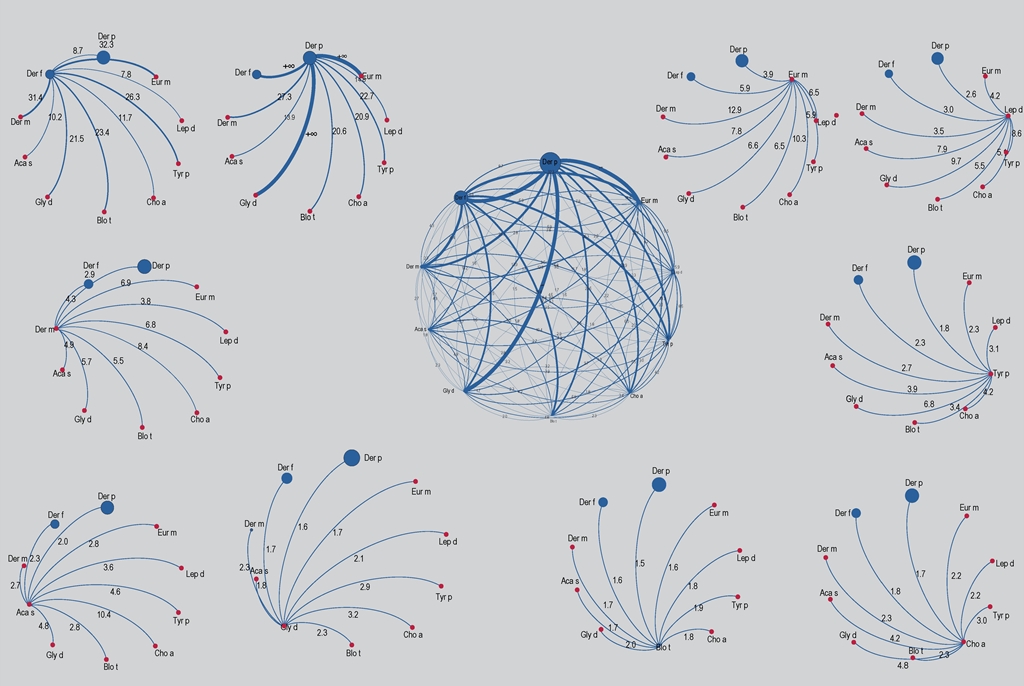
Figure 2 Represent graphically the probability of a mite sensitization resulting from sensitization to another. In the center, all the possibility reasons and around the relationship of each one. The intensity of the lines and nodules represents the likelihood of sensitization to each mite.
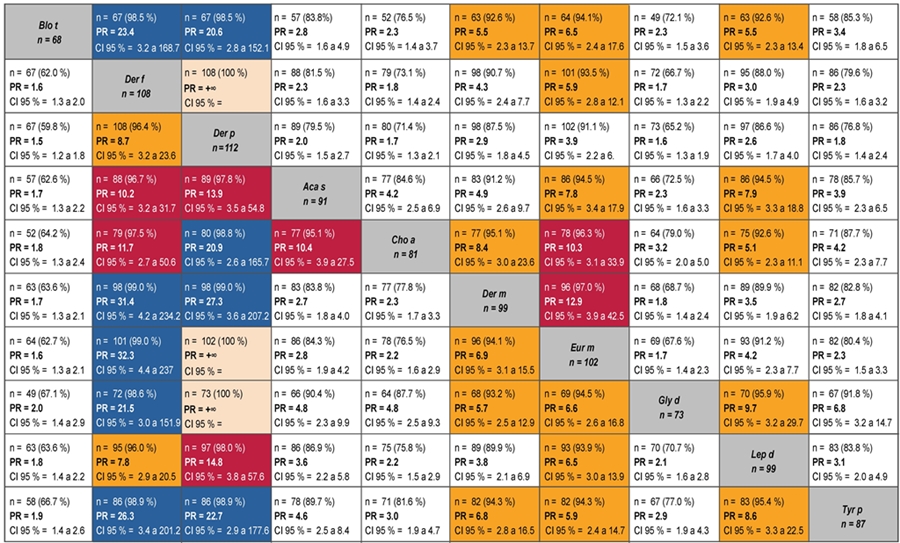
Figure 3 In beige the reasons for infinite probability; 20 more blue, red between 10 and 19, and yellow greater than 5. The interpretation of figure is made according to the meeting point of the columns and rows: Example: It is 23.4 times more likely than patients with awareness Der f t Blo present awareness about those who have no awareness der f. It is 1.6 times more likely than patients with sensitization to Blo t present awareness Der f respect to those who have no awareness Blo t. Results adjusted for age and sex manifestations of asthma, rhinitis, dermatitis and conjunctivitis
Sensitization to mites from Chortoglyphidae or Acaridae family also increased the risk of sensitization to other mites but less than 5 times. The only exception was the likelihood of sensitization to Cho a an among patients sensitized to Aca s that was 10 times, while the probability of Aca s sensitization among sensitized Cho a was 4 times. In the family Glycyphagidae notable discrepancies were found; Lep d sensitization increased 3 to 8 times the likelihood of sensitization to other mites; while sensitization to Blo t or Gly d increased the probability less than 3 times, including mites of the same family
Discussion
Mites found in house dust mostly belong to the suborder Astigmata. Little keratinized cuticle and skin breathing characterize them. The most widely distributed species belong from four families; Acaridae, Glycyphagidae, Pyroglyphidae and Chortoglyphidae. In 1928 Dekker suggested that bronchial asthma associated with house dust could be caused by mites present in the dust.17 This hypothesis was confirmed in 1964 by Voorhorst et al.,18 who demonstrated for the first time that genus Dermatophagoides are responsible of respiratory allergies. Subsequently it is shown that other mites can also influence allergies.19
We evaluate in an allergic population frequency of sensitization to 10 mites and their possible interactions. Mite’s distribution depends on certain environmental conditions; however, the genus Dermatophagoides has almost cosmopolitan distribution. The family Glyciphagidae by contrast, requires conditions of high temperature and preferably higher humidity, so its distribution is less widespread.
According to what was observed in other studies, we found that mite sensitization more frequently found among patients with allergic manifestations were the 4 species for Pyroglyphidae family. This would indicate that these mites are the most prevalent in the environment of the population evaluated. High co-sensitization of Pyroglyphidae species and high correlation in the size of wheals, suggest that there is also a high rate of cross-reactivity between them.
Some studies as Haahtela, et al.,20 observed a correlation between the size of wheals and clinical relevance; in the cohort PIAMA21 the number of sensitizations was directly correlated with patient age, suggesting that early sensitization and intensity of skin reaction are factors that can determine the patient’s prognosis. We found that there was a direct relationship between age and the number of sensitizations, up to 40 years, suggesting that early sensitization is an important risk factor for poly-sensitization, perhaps due to chronic inflammatory state, which would facilitate the IgE response to new species especially to allergens with share epitopes with allergens of previous sensitized mites, perpetuating the inflammatory cycle. The lower sensitization in the group over 40 years indicates perhaps a late onset of symptoms, or a loss in the number of sensitizations in time. We believe that the first scenario is more likely because patients over 40 usually referred onset of symptoms after the third decade of life (Data no available). A weakness of the study is not to have a greater number of patients younger than 5 years, which perhaps would identify what was the primary sensitizer mite.
When we assess probability reasons, we found that Der f and Der p were the main risk factor for sensitization to other sources, increasing more than 20 times the likelihood of sensitization to other mites from Pyroglyphidae family and more than 10 times sensitization mites other families. Moreover, this indicates that sensitization to Der f and Der p is a major risk factor for poly-sensitization to other mites and possibly other sources with which it shares proteins, which would explain the high frequency of sensitization to insect and other sources observed in previous studies in the same population.22 Additionally we note that sensitization to Der p confer an increased risk of sensitization to Der f, so between the two, Der p appears to be the main sensitizer. For families Chortoglyphidae and Acaridae the frequency of sensitization was a little lower than for Pyroglyphidae but was present in more than 50 % of the study population.
The correlation of wheal size in the family Acaridae was high (r 0.703), but interestingly both Tyr p as Aca s had a high correlation with Cho a (r 0.788 and 0.680 respectively), even higher than that found among them. The taxonomy of mites is complex and is not yet resolved, so the high co-sensitization found between Acaridae and Chortoglyphidae family and the high correlation in the size of wheals, it is may be because taxonomically share common ancestors or principal allergens from both mites are the same. Proteomic alignment studies are necessary to known principal allergens and subsequent verification in vivo to decipher this relationship.
From the mites studied, only Gly d (49 %) and Blo t (46 %) had a sensitization lower of 50 %, both from the family Glycyphagidae. Additionally, we observe that the 3 mites of this family had little correlation to the size of the wheal among themselves and with other mites, except for the case of Lep d and Cho a who had a high correlation, which is remarkable because both come from different families. Also, the likelihood of sensitization to other mites among patients sensitized to Gly d and Blo t was very low compared with mites Pyroglyphidae, Acaridae or Chortoglyphidae family, indicating that principal allergens for these species have low cross-reactivity and therefore specific species.
The above-described results may have important implications for both, the diagnosis and treatment of allergic patients: In the diagnostic battery, is necessary to include species Der p and Der f because they are the most frequently found and are a risk factor for sensitization to other mites; They should also be included Gly d and Blo t because they are sources of sensitization with slight relationship with other mites. For immunotherapy in patients sensitized to multiple mites, Der p and Der f should be included in a higher concentration, as they probably represent the initial source of sensitization. With only the administration of this combination specific allergens of Pyroglyphidae family will be included but also the principal allergens with cross-reactivity to other species. However, because Gly d and Blo t appear to represent an independent sensitization, it would be necessary to include in the therapeutic extract if patients are sensitized to them.
In conclusion, the frequency of sensitization to multiple mites is high in the tropics, with sensitization to Der p as important risk factor for poly-sensitization. It is therefore necessary to identify which sources are present in each region as well as determine which have a real clinical impact.











 text new page (beta)
text new page (beta)

